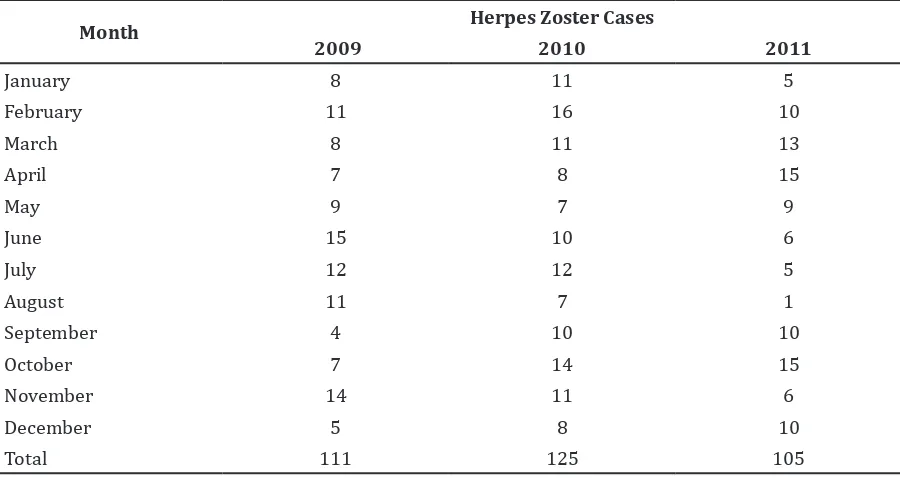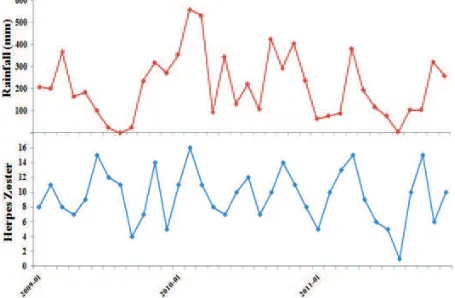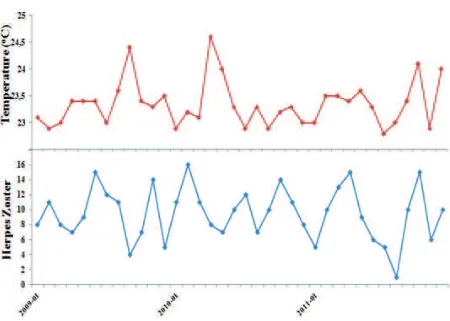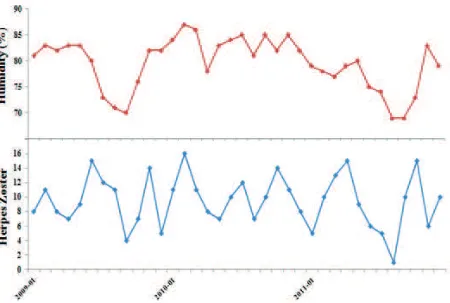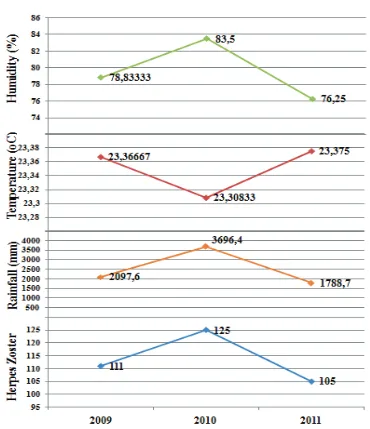Incidence of Herpes Zoster in relationship with Climate Factors from
2009 to 2011
Herning Adinda,1 Dendi Sandiono,2 Ihrul Prianza Prajitno3
1Faculty of Medicine, Universitas Padjadjaran, 2Department of Dermatology and Venereology, Faculty of Medicine, Universitas Padjadjaran/Dr. Hasan Sadikin General Hospital Bandung,
3Department of Anatomy and Cell Biology, Faculty of Medicine, Universitas Padjadjaran
Abstract
Background: Herpes zoster, or shingles, is a skin or mucous infection caused by the reactivation of varicella-zoster virus (VZV). Seasonal pattern of herpes varicella-zoster incidence was reported in some countries, indicating that emergence of this disease was caused by the reactivation of latent Varicella-Zoster Virus (VZV) rather than new exposures to VZV. On the other hand, the VZV primary infection difference between tropical and temperate zones may have implications for virus reactivation as herpes zoster. The aim of this study was to identify the incidence of herpes zoster in Dr. Hasan Sadikin General Hospital Bandung, West Java related to the change of rainfall, air temperature and humidity from 2009 to 2011.
Methods: A descriptive retrospective study was carried out to 341 medical records of herpes zoster patients from Dr. Hasan Sadikin General Hospital Bandung periode 2009 to 2011. Data on climate factors, i.e. rainfall, air temperature, and relative humidity, were obtained from the Indonesian Meteorology, Climatology, and Geophysical Agency. The collected data were presented using tables and figures.
Result: The highest number of herpes zoster cases occured during the period when the highest annually total rainfall and annually mean relative humidity occurred.
Conclusions: The finding of this study shows that herpes zoster cases have the same pattern with the rainfall and relative humidity. These findings can inform better prevention of herpes zoster. However, further research is needed to get more comprehensive understanding on this relationship. [AMJ.2015;2(3):332–38]
Keywords: Air temperature, herpes zoster, rainfall, relative humidity
Correspondence: Herning Adinda, Faculty of Medicine, Universitas Padjadjaran, Jalan Raya Bandung-Sumedang Km.21, Jatinangor, Sumedang, Indonesia, Phone: +62 8998928936 Email: herning_adinda@yahoo.com
Introduction
Herpes zoster, or shingles, is a skin or mucous infection caused by the reactivation of varicella-zoster virus (VZV) and is characterized by unilateral radicular pain and vesiculars eruption that is generally limited to the dermatome innervated by a single spinal or cranial sensory ganglion.1,2 Varicella-zoster virus is a ubiquitous herpes virus that causes two different syndromes, these are varicella (chickenpox) which is primary infection, and herpes zoster (shingles).3,4 Patients with herpes zoster experience local neuritic pain and moreover, patients’ quality of life may
significantly be impaired.3 The incidence of Herpes zoster increases from 7.6 per 10,000
persons during 1945−1947, to 16.4 per 10,000
persons during 1980−1982, to 29.5 per 10,000
persons during 2005−2007.5 Seasonal pattern
of herpes zoster incidence was not seen in most studies, indicating that the disease was caused by the reactivation of latent VZV rather than new exposures to VZV.1,4,6 On the other hand, the VZV primary infection difference between tropical and temperate zones may have implications for virus reactivation as herpes zoster.7
herpes zoster related to the change of rainfall, air temperature and humidity in Dr. Hasan Sadikin General Hospital Bandung, West Java during the period of 2009 to 2011.10,11
Methods
A descriptive retrospective study was conducted to investigate the pattern of herpes zoster in relationship to climate factors in Dr. Hasan Sadikin General Hospital Bandung during the period of 1 January 2009 to 31 December 2011. Total cases were obtained from medical records of Dr. Hasan Sadikin General Hospital Bandung with total sampling technique. The inclusion criteria were medical records from patients of herpes zoster who were diagnosed based on clinical examination
and patients being admitted for the first
time during the period of 1 January 2009 to 31 December 2011. Patients living outside Bandung were excluded.
Medical records for all the cases fulfilling
the inclusion criteria were retrieved. Relevant demographic and admission data were extracted from medical records. Relevant demographic data included address of the patients, while relevant admission data included the month and year of hospital admission. All collected data in Dr. Hasan Sadikin General Hospital Bandung were approved by the Health Research Ethics
Committee. The meteorological data including monthly total rainfall, monthly mean air temperature, and monthly mean relative humidity were obtained from the Indonesian Meteorology, Climatology and Geophysical Agency during January 2009 to December 2011. The collected data were presented by tables and graphs.
Results
Four hundred and seventy two medical records from patients with herpes zoster were reviewed, 131 cases were excluded according to the exclusion criteria and 341 cases were included in this study. The monthly herpes zoster cases from 2009 to 2011 ranged from 1 to 16 per month.
There were fluctuating numbers of monthly
reports of herpes zoster cases in consecutive three years with the highest occurrence on June 2009, with 15 number of cases were reported, on February 2010 with 16 number of cases were reported, and 15 number of cases were reported on April and October 2011. The highest number reported in 2010 was 125 cases (Table 1).
There were fluctuating numbers of monthly
total rainfalls. The highest total rainfall occured in March 2009, February 2010, and April 2011. The lowest total rainfall occurred in August 2009, April 2010 and August 2011.
Table 1 Monthly Distribution of Herpes Zoster cases in Dr. Hasan Sadikin General Hospital
There were fluctuating numbers of monthly
mean temperatures with the highest monthly mean temperature occurred in September 2009, April 2010 and October 2011. The
lowest monthly mean temperature occurred in February 2009, January, July and September
2010, and July 2011. There was a fluctuating
amount of monthly mean relative humidity in
Table 2 Rainfall, Temperature, and Relative Humidity per Month in 2009−2011
Month Rainfall (mm) Temperature (oC) Relative Humidity (%)
2009 2010 2011 2009 2010 2011 2009 2010 2011
January 208,5 353,3 63,0 23,1 22,9 23,0 81 84 79
February 200,5 557,1 76,7 22,9 23,2 23,5 83 87 78
March 365,7 531,0 89,4 23,0 23,1 23,5 82 86 77
April 165,6 93,0 381,5 23,4 24,6 23,4 83 78 79
May 183,8 345,0 193,4 23,4 24,0 23,6 83 83 80
June 101,0 131,9 117,6 23,4 23,3 23,3 80 84 75
July 24,2 220,8 77,2 23,0 22,9 22,8 73 85 74
August 0,5 106,1 3,1 23,6 23,3 23,0 71 81 69
September 24,0 424,4 102,8 24,4 22,9 23,4 70 85 69
October 234,5 292,2 103,6 23,4 23,2 24,1 76 82 73
November 318,2 404,1 321,4 23,3 23,3 22,9 82 85 83
December 271,1 237,5 259,0 23,5 23,0 24,0 82 82 79
Figure 1 Monthly total rainfall and monthly distribution of herpesvzoster cases in Dr.
the consecutive three years with the highest monthly mean relative humidity occurred in February, April and Mei 2009, February 2010, and November 2011. The lowest monthly relative humidity occurred in September 2009, April 2010, also August and September 2011. There were similarities between total rainfall, monthly mean temperature and monthly mean relative humidity in the consecutive three years and the highest number per month was reported in 2010 (Table 2).
The monthly distribution of herpes zoster cases in Dr. Hasan Sadikin General Hospital Bandung is shown in Figures 1, 2 and 3. The periodicity of various climatic factors, namely monthly total rainfall, monthly mean air temperature, and monthly mean relative humidity were also shown.
There were pattern similarities between herpes zoster cases and rainfall in 2010–2011 shown by the highest number of herpes zoster cases in February and April, respectively. Then, it was followed by the highest number of monthly total rainfall, and the lowest number of herpes zoster cases in August 2011 followed by the lowest number of monthly total rainfall
(Figure 1). In 2009, there was no pattern similarity between herpes zoster cases and monthly rainfall, which was most likely caused by the very low monthly total rainfall (0.5 mm) in August.
There was no pattern similarity between herpes zoster cases and monthly mean temperature, because in 2009, the lowest number of herpes zoster cases in September was followed by the highest monthly mean temperature (Figure 2). While in 2011, contrary to what happened in 2009, the highest number of herpes zoster cases in October was followed by the highest monthly mean temperature.
There were pattern similarities between herpes zoster cases and monthly mean relative humidity in 2009 to 2011 shown by the lowest number of herpes zoster cases in September and August, respectively followed by the lowest monthly mean relative humidity (Figure 3).
There were pattern similarities between total annually rainfall, annually mean relative humidity and annually mean air temperature shown by the highest number of herpes zoster cases in 2010, followed by the highest total
Figure 2 Monthly mean air temperature and monthly distribution of herpes zoster cases
annually rainfall, the highest annually mean relative humidity and the lowest annually mean temperature (Figure 4).
Discussion
The annually herpes zoster cases increased from 111 cases in 2009 to 125 cases in 2010, yet decreased to 105 cases in 2011. The total rainfall and mean relative humidity were found to have the same pattern with the number of herpes zoster cases.
It has been suggested that the herpes zoster occurs without seasonal pattern and there is little evidence of seasonality in zoster incidence from the population-based studies.1,4,6 In some countries, the seasonal pattern was reported. Meanwhile, Scottish and English studies4 reported higher incidence of zoster in summer and autumn. A large-scale survey in Japan6
clarified the epidemiology of herpes zoster
with peak incidence in August and the lowest in winter in contrast to western countries. A Korean study6 suggested that the most cases of herpes zoster were recorded during summer, and the least during autumn. Data from a study
in Pakistan6 also support surge of the cases of herpes zoster noted with onset in summer season in April, May, and June. This pattern might be related to ultraviolet irradiation that peaks during the summer months can leads to a suppression in the cellular immune response to VZV, thus allowing reactivation of the virus from latency in some individuals.6,12
This study showed the different outcome from the above mentioned research, the herpes zoster cases had the same pattern with total rainfall and mean relative humidity. Reactivation of latent VZV occurred after a variable period ranging from a few years to decades after primary varicella infection.6 It is unclear what induces reactivation of VZV, but it is assumed to occur as a result of aging-related decreasing of cell-mediated immunity to VZV, that is when cell-mediated immunity decreases below a crucial level.3,4
The depression of specific cell-mediated
immunity may be triggered by age, genetic predisposition, trauma, sunburn, exhaustion, psychological stress, immunosuppression or irradiation.6 However, the exact mechanism for the potential association between rainfall and humidity and herpes zoster cases is
Figure 3 Monthly mean relative humidity and monthly distribution of herpes zoster cases
unknown. A hypothesize can be raised that climate change will affect human health in many ways and climate change is projected to increase threats to human health, particularly in lower income populations and tropical/ subtropical countries.13,14 People living in high climate change areas will be more susceptible to VZV reactivation. Another possibility can be that developing countries are more sensitive to climate change, as they have poor public health infrastructure and more vulnerable populations.15 In addition, Indonesia, particularly Bandung, has a different season with other countries as mentioned in previous
researches. However, all these hypotheses need further studies to explore the association between rainfall and relative humidity with herpes zoster.
For temperature, there was no pattern similarity, because the highest herpes zoster case was followed by the highest temperature and the lowest temperature. The possibility could be that both extreme cold and hot temperatures had immediate negative impacts on all mortality types and age groups.15
This study has some limitations. First, it is based on medical records, and therefore, patients with mild disease were excluded due
Figure 4 Annually total rainfall, mean air temperature, mean relative humidity and annually distribution of herpes zoster cases n Dr. Hasan Sadikin General Hospital
to absence of hospital visit. Second, longer data collection, as long as 5 years or more is recommended in order to obtain clearer patterns. Third, we have not found appropriate references of similar research, which make
it difficult to compare. Apart from potential
weather attributes, other environmental and host factors may also affect the herpes zoster cases. Further studies to incorporate more variables such as age, sex and psychological stress state are warranted in the future.
In conclusion, the findings of this study
show that herpes zoster cases have the same pattern with the rainfall and relative humidity.
These findings are useful for a further research
of the relationship between herpes zoster with climate factors and also to enhance the prevention of herpes zoster. To ensure that there is a correlation of herpes zoster with climate factors, more advance research should be carried out by conducting an analytic study and analytic examination of that relationship in a longer period of 5 years or more. Preventive measures against the spread of herpes zoster in conjunction with the rain factor can be programmed by educating people to maintain a healthy life style and to boost their immune system for the incoming rain season. While in conjunction with the high humidity can be conducted by educating them to maintain a healthy environment, and increasing more house openings to improve the house
ventilation to let more sunlight flowing into the house. A dehumidifier, which can be
purchased from local stores can be installed in the house to help reducing the humidity.
References
1. Freedberg IM, Eisen AZ, Austen KF, Goldsmith LA, Katz SI, Wolff K, editors. Fitzpatrick’s dermatology in general medicine. 6th ed. New York: The McGraw-Hill companies; 2003.
2. Djuanda A, Hamzah M, Aisah S, editors. Ilmu penyakit kulit dan kelamin. 6th ed. Jakarta: Fakultas Kedokteran Universitas Indonesia;2010.
3. Weinberg JM. Herpes zoster: epidemiology, natural history, and common complications. J Am Acad
Dermatol. 2007;57(6 Suppl):S130−5.
4. Thomas SL, Hall AJ. What does epidemiology tell us about risk factors for herpes zoster? Lancet Infect Dis.
2004;4(1):26−33.
5. Yawn BP, Wollan P, Bialek SR, Harpaz R. Trends in herpes zoster prevalence in a
population based cohort from 1945 to 2008. Proceeding of The 48th Annual Meeting of the Infectious Diseases Society of America; 2010 Oct 21–24; Vancouver, Canada. Arlington, VA: Infectious Diseases Society of America. 2010
6. Suhail M, Ejaz A, Abbas M, Naz S, Suhail T. Herpes zoster: seasonal variations and morphological patterns in Pakistan. J Pak
Assoc Derma. 2011;21(1):22−6.
7. Rice PS. Ultra-violet radiation is responsible for the differences in global epidemiology of chickenpox and the evolution of varicella-zoster virus as man migrated out of Africa. Virol J. 2011;8:189. 8. Rafi’i DS. Meteorologi dan klimatologi.
Bandung: Angkasa; 2010.
9. Sungkawa D. Geografi regional
Indonesia. Bandung: Universitas Pendidikan Indonesia; 2011. [cited 2011 November22]. Available from:
http://file.upi.edu/Direktori/FPIPS/JUR._
PEND._GEOGRAFI/195502101
980021-DADANG_SUNGKAWA/Bahan_ Ajar_GRI/GRI_Gabungan_ Cetak.pdf.
10. Pusat Inventarisasi dan Statistik Kehutanan Badan Planologi Kehutanan Departemen Kehutanan. Data dan informasi kehutanan Propinsi Jawa Barat; 2002. [cited 2011 November22]. Available from: http://www.dephut.go.id/ INFORMASI/INFPROP/Inf-Jbr.pdf.
11. BMKG. Informasi perubahan iklim dan kualtias udara. Jakarta: Badan Meteorologi
Klimatologi dan Geofisika; 2012. [cited
2012]. Available from: http://www. bmkg.go.id/BMKG_Pusat/DataDokumen/ Dokumen_Buku_Informasi_Perubahan_ Iklim_dan_Kualitas_Udara.pdf.
12. Zak-Prelich M, Borkowski JL, Alexander F, Norval M. The role of solar ultraviolet irradiation in zoster. Epidemiol Infect.
2002;129(3):593−7.
13. Haque AM, Yamamoto SS, Malik AA, Sauerborn R. Households’ perception of climate change and human health risks: a community perspective. Environ Health. 2012;11:1.
14. Forsberg B, Braback L, Keune H, Kobernus M, Krauss MKv, Yang A, et al. An expert assessment on climate change and health–with a European focus on lungs and allergies. Environ Health. 2012;11(Suppl1):S4.
